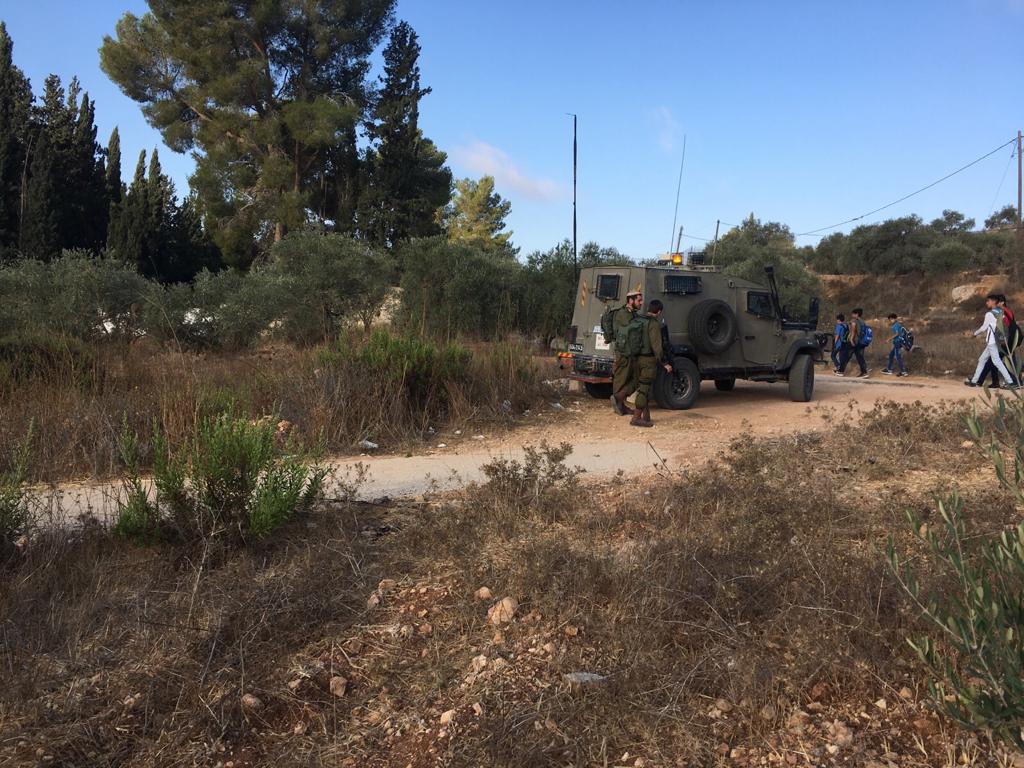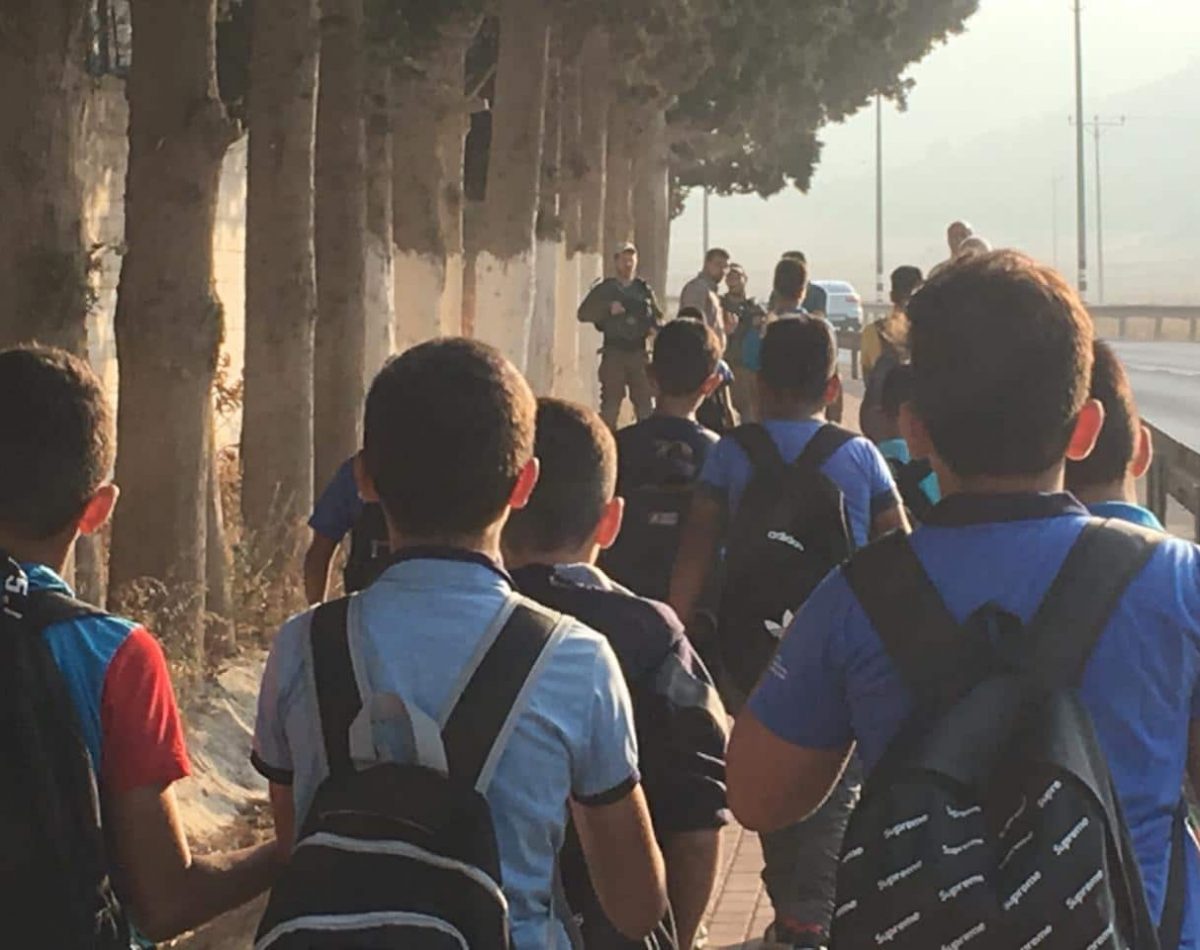‘Being here is aggressive to the eye, to the ear, to the soul of the students’
Sameh, school teacher
Route 60 runs 235km from the Israeli city of Beersheva to the Israeli city of Nazareth and is one of the few roads that allows uninterrupted travel from the north of the West Bank to the south. It connects the Palestinian cities of Jenin in the north to Hebron in the south, linking both with Jerusalem. This major transport route is an important route for the many Israeli settlements that line its path.
Restricting the movement of the Palestinian population is one of the tools that Israel uses to control and occupy the West Bank and many of these disruptive strategies are evident along Route 60. Restrictions on Route 60 include separate bus stops for Palestinians and Israeli settlers (with settler bus stops being protected by groups of armed Israeli soldiers), the separation barrier, countless roadblocks, military checkpoints, flying checkpoints (temporary checkpoints that appear unexpectedly) and forced diversions. Approximately 25,000 acres of private Palestinian owned land has been annexed in order to create Israeli settlements in the West Bank. Some of this land is also used to create Israeli settler only roads and expand existing roads to improve the road network for settlers.
As Sawiya Al-Lubbin School was established in 1944 before the state of Israel in 1948 came into existence and is located along Route 60. It educates approximately 500 Palestinian students from two villages. It is a mixed secondary school – a small number of girls who want to study science subjects in their final year attend the predominantly boys school. In many ways, it’s an idyllic, rural location; beside the school are fields of olive trees and at the other side of the road is a small traditional Palestinian herding (Bedouin) community. Students walk to school in groups and on Thursdays they are often walking with their book open as they revise for the end of week exams.
Opposite the school on the top of a steep hill, the edge of Shilo Israeli settlement is visible. Referred to as Ancient Shilo on signposts (it was established in 1979), it is home to over 4,000 settlers who according to the settlement’s website, share a ‘desire to live in a modern religious Jewish environment and assume the responsibilities of a pioneering society’. The Guardian’s ‘Meet the Settlers’ describes it as,
‘a strikingly tranquil place, alive with birdsong and the scent of eucalyptus… Israel claims that the land had been abandoned and was legitimately claimed by the state; local Palestinians and Israeli human rights groups maintain that at least a quarter of the settlement is built on private Palestinian land’.
Unfortunately, the existence of this society has severe consequences for local Palestinian villages and in particular the students and staff of As Sawiya Al-Lubbin School. The school is one of 13 West Bank schools which contend with a military presence outside the school on a daily basis. For these students, getting to and from school is a political issue. This school had more verified attacks than any other school in Palestine in 2015 and is considered one of the most vulnerable in the West Bank.
Soldiers arrive at the Eastern entrance to the school
On the 17th October 2019, one student on his way to school was temporarily detained by soldiers but released after teachers intervened. Everyday, between eight and 12 soldiers armed with M16s arrive at 7:30am. Locals have observed that their role is not to protect students from settlers’ aggression but is instead to protect the settlers who drive on Route 60 from students walking to and from school.
Approximately 750,000 settlers live in the West Bank and are provided with military protection. Breaking The Silence, an Israeli NGO who have collected more than 1,000 soldiers’ testimonies conclude in ‘The High Command’:
‘the military defines its soldiers’ primary task to be protection of settlers… being citizens of Israel who reside there. However, in accordance with commanders’ instructions and the norms in the field, soldiers usually do not tend to consider guaranteeing the safety of the Palestinians as a mission they are obliged to as well. This situation is an inevitable product of the Israeli military’s mechanism of control that has been forming for nearly half a century; a situation in which two populations live in the same geographical area – one enjoying full civil rights subject to the civilian law enforcement system (settlers), and the other disenfranchised and subject to military law enforcement (Palestinians). In such scenario, the sovereign force in the territory … perceives itself as committed to the defence of one group only, while almost completely ignoring its duty toward the other’.
Each morning, soldiers stand in groups of twos and threes on or beside the path and at the main entrance to the school and sometimes at the opposite side of the road, often in the entrance of a Palestinian house, so the families have no choice but to contend with armed soldiers when they leave their house.
Most mornings, there are eight soldiers on the main road and three standing outside the eastern entrance. After school begins at 8am, the soldiers sit under trees nearby and have breakfast. At the end of the school day, the soldiers resume their positions as the students leave the school. The students have to walk past heavily armed soldiers at close range. The teachers at the school tell us that the soldiers’ presence often seems more likely to provoke than to deter – students and teachers frequently report soldiers checking school bags, accusing students of taking photos of them, intimidating students, standing across the path so that students have to walk around them and speaking crudely and inappropriately to the female students. The soldiers are doing their required three years of military service and most of them are young in appearance – they are around 18 or 19 years of age and similar in age to the older students.
Palestinian children face soldiers on their route to school



